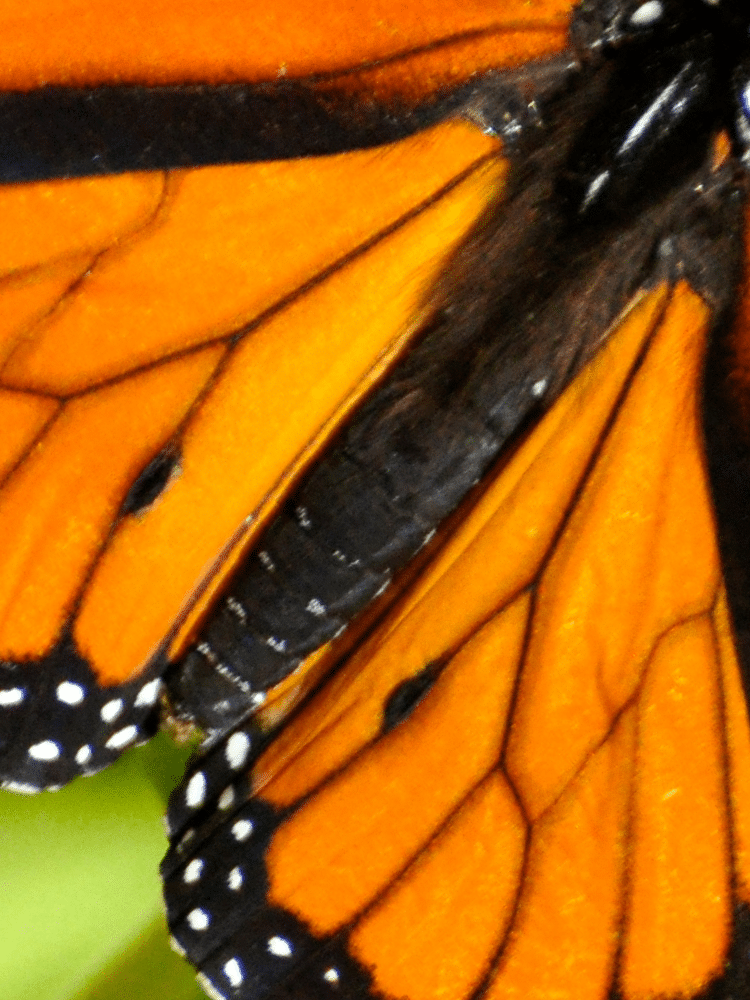We all know what a butterfly looks like. They’re probably one of the most popular insects you’ll come across in the garden. But what do you know about them besides their incredible appearance? Let’s consider the basics: What do butterflies eat?

Although it varies from species to species, the list of things that a butterfly consumes is quite simple. I’ve explained each fully below but here’s a quick list of the most popular things that a butterfly eats:
You can click any of the links in this list to navigate to the relevant spot in this guide to what butterflies eat.
Nectar
Like many insects, butterflies rely heavily on nectar. It’s why you’ll often see butterflies on blooming flowers in your garden.
What is Nectar?
Imagine the most divine, sugary drink nature could concoct for its beloved winged wonders – that’s nectar. It’s a sweet liquid produced by flowers, primarily designed to attract pollinators like bees, hummingbirds, and, of course, butterflies.
The nectar serves a dual purpose: it feeds the pollinators and, in return, it helps the flowers reproduce by transporting pollen.
The composition of nectar is mostly water, but it’s the dissolved sugars, primarily sucrose, that make it a high-energy treat. Additionally, it contains various amino acids, vitamins, and other nutrients, making it a balanced dietary source for butterflies.
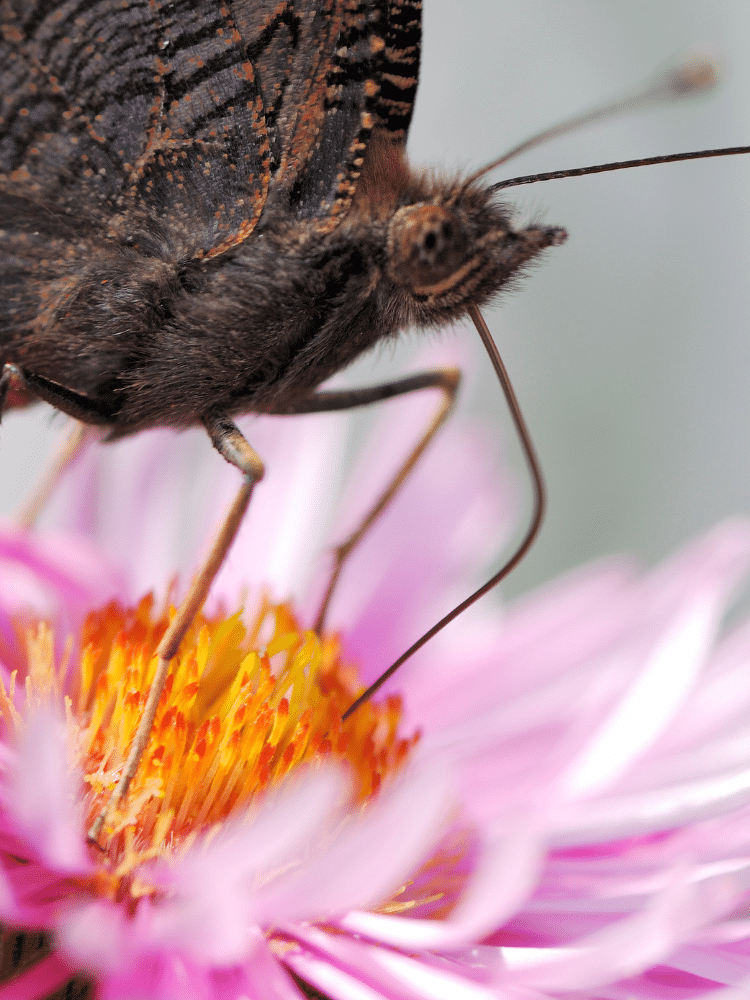
Nectar is a Popular Choice
While all butterflies can feed on nectar, a whopping 90% of them rely on it as their primary food source. That’s a testament to how vital nectar is in the butterfly world.
Some species are even adapted specifically to certain flowers, showcasing a beautiful evolutionary dance between the plant and the insect.
How Do Butterflies Collect Nectar?
Let’s talk about the star player in the nectar-sipping game: the proboscis.
This long, coiled, tube-like tongue might seem delicate, but it’s an engineering marvel. When a butterfly lands on a flower, it unrolls its proboscis, delving deep into the flower to access the nectar reservoirs.
The proboscis structure, with its tiny hair-like structures, helps it soak up nectar efficiently, like a straw.
But there’s more. The proboscis isn’t just a static structure. Butterflies can actually sense the quality and quantity of the nectar with it. Some research indicates they can even discern sugar concentrations, ensuring they always get the best bang for their buck.
Which Flowers Do Butterflies Collect Nectar From?
Butterflies are particular. They know what they do and don’t like. This is why you might see one species hovering around one flower but avoiding all the others you’ve planted. Below is a list of flowers that specific species enjoy collecting nectar from:
- Sunflower: Painted Ladies, Monarchs.
- Coneflower: Eastern Tiger Swallowtails, Black Swallowtails.
- Zinnia: Gulf Fritillaries, Skippers.
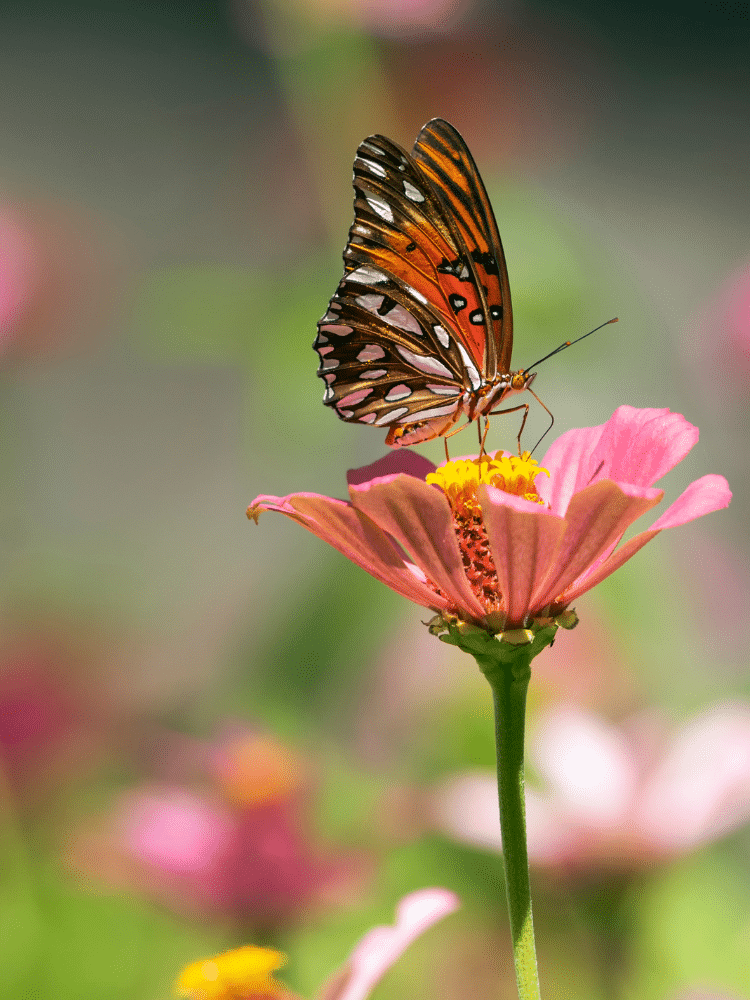
- Lantana: Red Admirals, American Ladies.
- Milkweed: Monarchs, Queens.
- Butterfly Bush: Great Spangled Fritillaries, Painted Ladies.
- Joe-Pye Weed: Spicebush Swallowtails, Eastern Tiger Swallowtails.
- Goldenrod: American Coppers, Pearl Crescents.
- Asters: Red Admirals, Painted Ladies, Monarchs.
- Blazing Star: Eastern Tiger Swallowtails, Gulf Fritillaries.
- Phlox: Clouded Sulphurs, Painted Ladies.
- Marigold: American Ladies, Skippers.
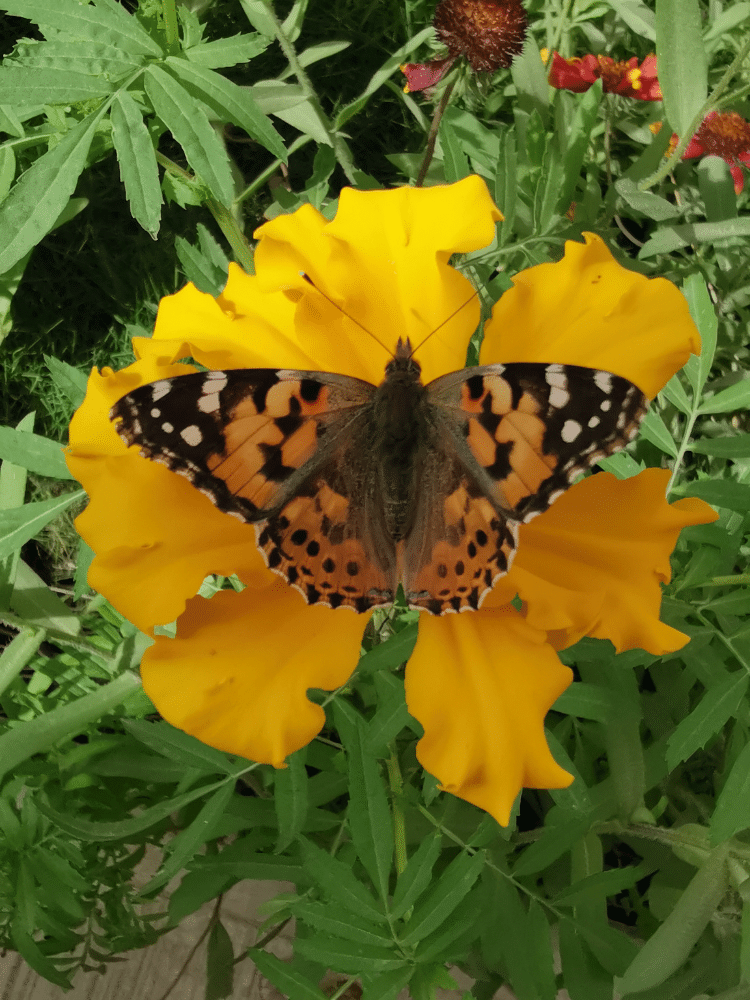
- Lilac: Black Swallowtails, Eastern Tiger Swallowtails.
- Lupine: Orange Sulphurs, Skippers.
- Daisy: Painted Ladies, American Coppers.
- Verbena: Gulf Fritillaries, Red Admirals.
- Black-eyed Susan: Eastern Tiger Swallowtails, Monarchs.
- Salvia: Skippers, Painted Ladies.
- Yarrow: Eastern Tiger Swallowtails, Clouded Sulphurs.
- Bee Balm: Monarchs, Great Spangled Fritillaries.
Other Food Sources
Although 90% of butterflies rely solely on nectar, a small group of butterflies go out of their way to consume other foods. So, what do these butterflies eat?
Overripe Fruit
While flowers and their nectar are a staple, butterflies often show a penchant for something a bit more… fermented.
Enter overripe fruits. You know those fruits in your garden or on your kitchen counter that have gone a tad too soft? They release sugars and other compounds that are pretty irresistible to some butterfly species.
This sugary feast offers an energy boost and can also be a source of vital minerals and salts. The next time you see a butterfly lingering around a rotting banana or a mushy mango, know it’s enjoying its own version of a fruity dessert!
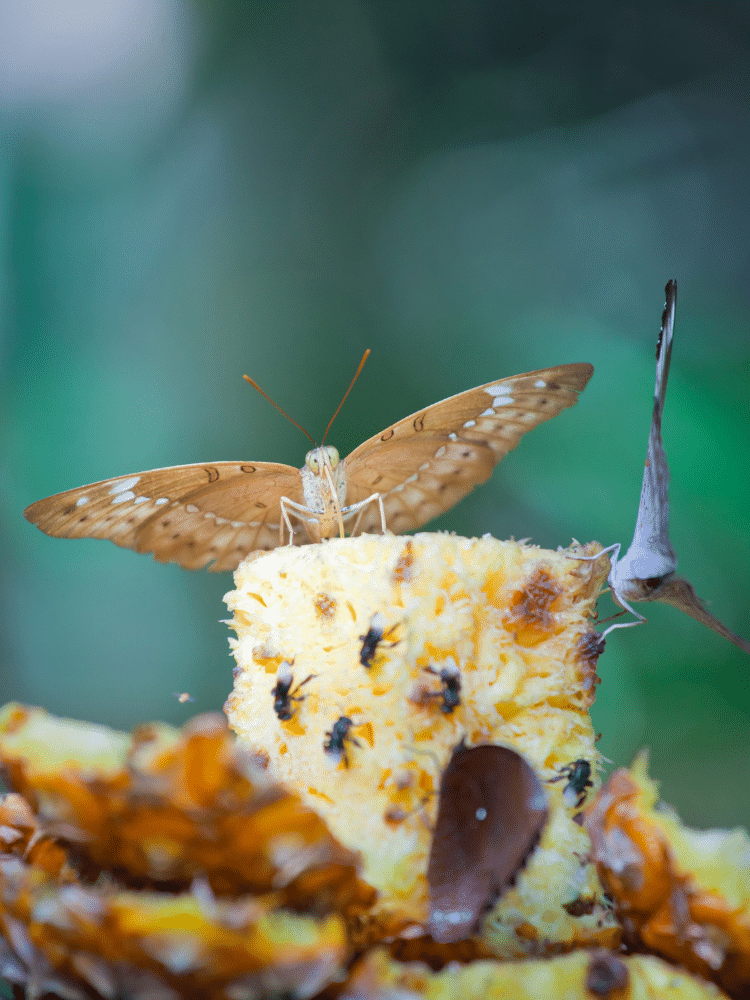
Tree Sap, Manure and Dead Animals
The dietary habits of butterflies can be, well, surprising to many. Tree sap contains sugars and minerals, especially when it’s fresh and oozing. Many butterflies are known to feed on it, savoring its rich contents.
But it doesn’t stop there.
Manure and carrion (yes, dead animals) are on the menu for some species too. Before you go “yuck”, consider this: these sources are packed with amino acids, salts, and other nutrients that might be scarce in a butterfly’s primary diet.
It’s all about survival and making the most of what’s available.
Vital Minerals
Butterflies aren’t dining on these alternate sources just for variety. There’s a method to the madness.
Certain minerals, particularly sodium and nitrogen, are essential for their reproduction and overall well-being.
For instance, the Tawny Emperor and the Eastern Tiger Swallowtail are often observed engaging in “puddling” (more on this below) – a behavior where they gather around mud puddles or damp grounds to absorb salts and minerals.
Male butterflies, in particular, often require extra sodium.
A classic example is the Pipevine Swallowtail. Male Pipevine Swallowtails are known to actively seek out sources of sodium, which they then pass on to females during mating to ensure healthy egg production.
Similarly, Red Admirals might feed on rotting fruits or bird droppings to obtain essential nutrients.
So when you spot a butterfly on an unusual food source, remember it’s often on a critical mineral hunt.
Puddling
Have you ever seen a cluster of butterflies chilling on wet sand or mud and wondered what the gathering was all about? This behavior is called “puddling,” and it’s like a happy hour for butterflies – minus the cocktails.
What is Puddling?
Puddling is when butterflies congregate on damp patches of ground. They’re slurping up essential minerals and salts from the wet soil. Think of it as their version of a mineral-rich smoothie.
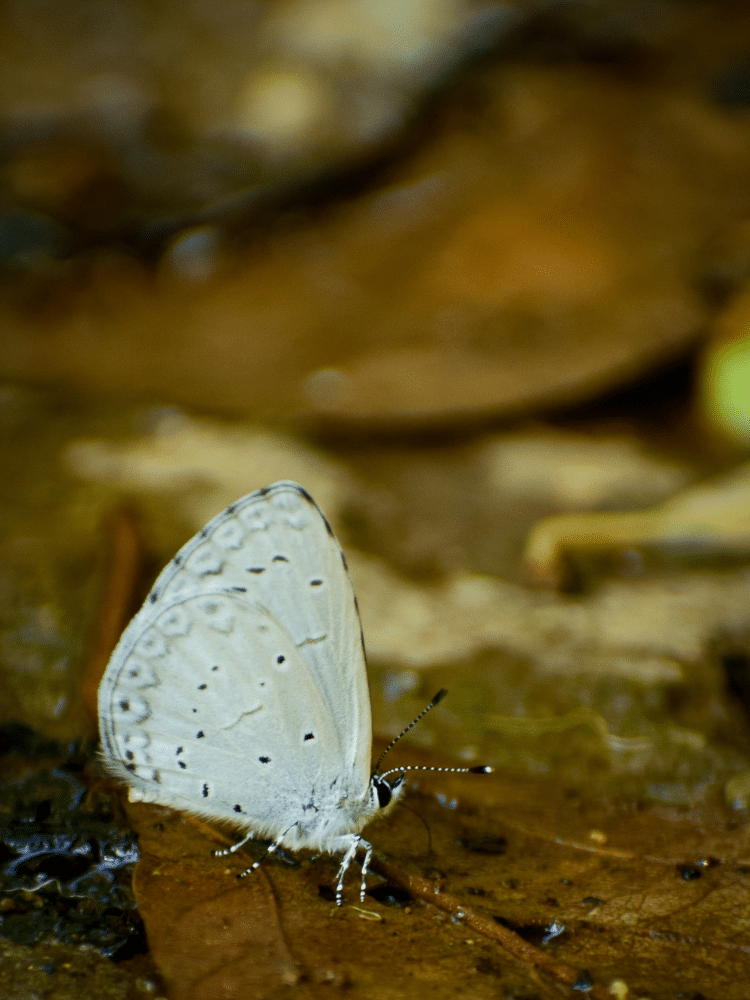
Why Do Butterflies Puddle?
While it’s a mesmerizing sight, puddling serves a crucial purpose. Butterflies, especially males, extract salts and minerals from these muddy spots.
These nutrients play a pivotal role in their reproduction cycle. When males mate with females, they pass on these salts, which can help with successful egg production. It’s nature’s way of ensuring the next generation gets a good start.
Unique Diets
The above outlines what most butterflies will consume. However, some butterfly species have unusual, weird, and unique diets.
- Harvester Butterfly: This is the only carnivorous butterfly in North America! Instead of feeding on plants, the harvester butterfly caterpillars prey on woolly aphids. They consume these tiny insects, benefiting from the nutrients they provide.
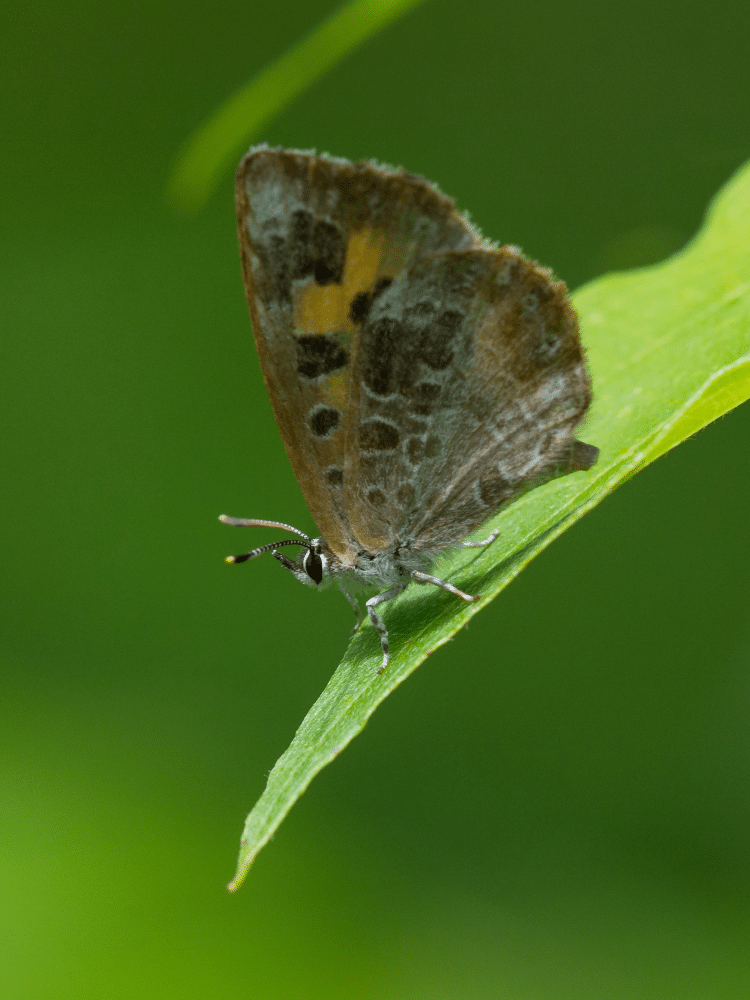
- Heliconius Butterflies: These butterflies are a fascinating group found in the tropics, particularly in the Amazon. Many Heliconius species practice “nectar theft” by piercing the base of a flower to get to the nectar without pollinating the plant.
- Purple Emperor: This butterfly, native to Europe, has a peculiar preference for animal droppings, particularly that of carnivores. They extract essential amino acids and salts from this seemingly unappetizing source.
- Julia Butterflies: Found in Central and South America, Julia butterflies display an extraordinary behavior: they drink the tears of turtles. This act, known as “lachryphagy,” provides the butterfly with essential salts and nutrients. The turtle gets its eyes cleaned, and the butterfly gets a drink — a perfect symbiotic relationship.
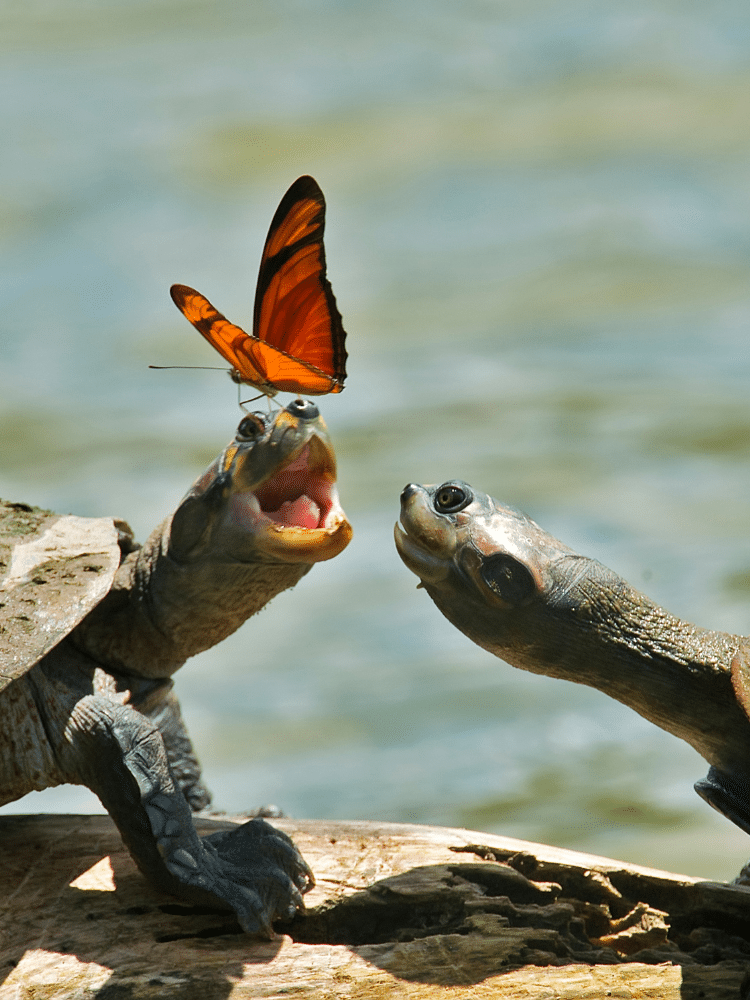
- Brimstone Butterfly: A European native, the Brimstone butterfly has a keen sense of smell, allowing it to detect and feed on honeydew (the sugary secretions of aphids) from high up in the tree canopy.
- Club Silverline Butterfly: Native to parts of India and Southeast Asia, this butterfly has been documented extracting minerals from wet patches in rocky terrains. While not unique, this behavior is rare given its specific habitat choice for mineral extraction.
What About Caterpillars?
If you’ve ever stumbled upon a leaf covered in tiny holes, there’s a good chance a caterpillar has been enjoying a hearty meal. These growing larvae are nature’s tiny eating machines, and their dietary choices can significantly affect ecosystems and our understanding of insect-plant relationships.
Although caterpillars are essentially baby butterflies, their diet could not be more different to their parents.
How Much Do Caterpillars Eat?
During their caterpillar phase, these creatures have an enormous appetite. They can consume up to 27,000 times their body weight during this stage of life. That’s like a human eating six double-decker buses in their lifetime!
To give you a sense of their munching power, a single caterpillar can eat about one square meter of foliage in its lifetime. With thousands of caterpillars in a single area, they can quickly deforest smaller plants and shrubs.
That’s why you might have full, healthy kale plants one day but nothing the next – blame the caterpillars!
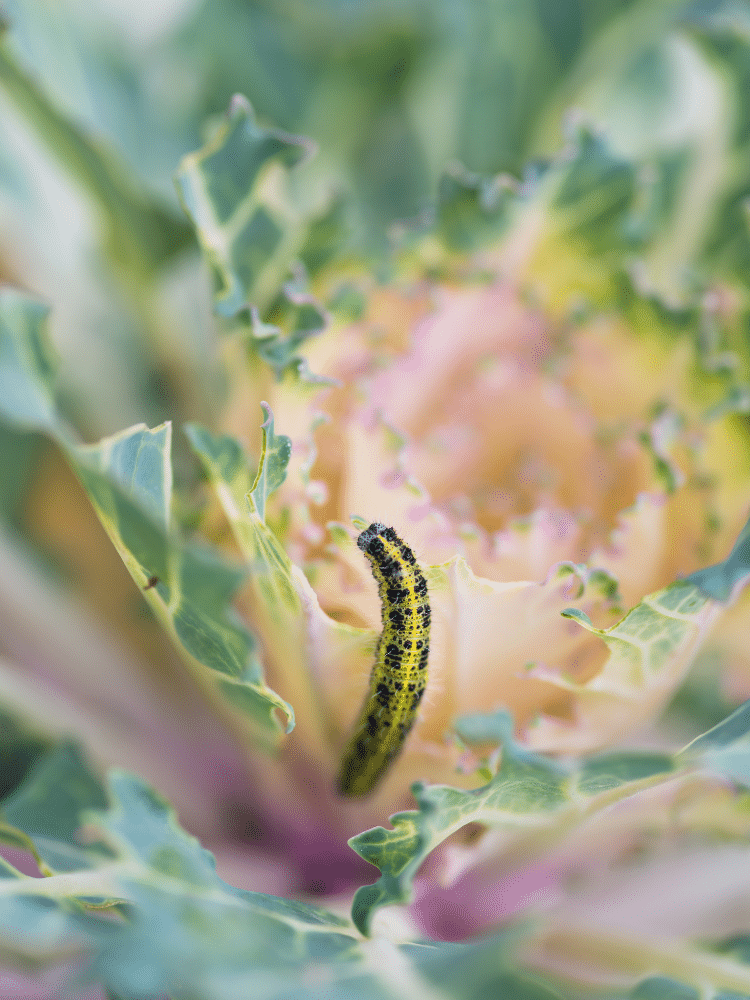
What Do Caterpillars Eat?
Every caterpillar has its particular taste when choosing a dining spot. Here’s a deeper dive into the varied palates of these fascinating creatures:
- Black Swallowtails: These caterpillars primarily favor the parsley family. Plants like dill, fennel, and Queen Anne’s lace often host these green and black-striped munchers. Historically, these larvae have even been mistaken for small snakes due to their unique appearance.
- Gulf Fritillaries: The orange and black spiky Gulf Fritillary caterpillars have a unique preference. Passion vines are their primary choice. Interestingly, the toxins in these vines give the caterpillars a bitter taste, which deters predators.
- Buckeye Caterpillars: These caterpillars have a diverse palate. Plantain, snapdragons, and ruellia serve as their primary food sources. Their bright, contrasting patterns of black and white make them easily recognizable.
- Eastern Tiger Swallowtails: Found munching on wild cherry, tulip tree, and birch leaves. Their green or brown appearance helps them camouflage against potential threats.
- Painted Lady Caterpillars: They adore thistles, hollyhocks, and sunflowers. Their spiky, black body, decorated with a series of yellow dots, is designed to deter birds and other predators.
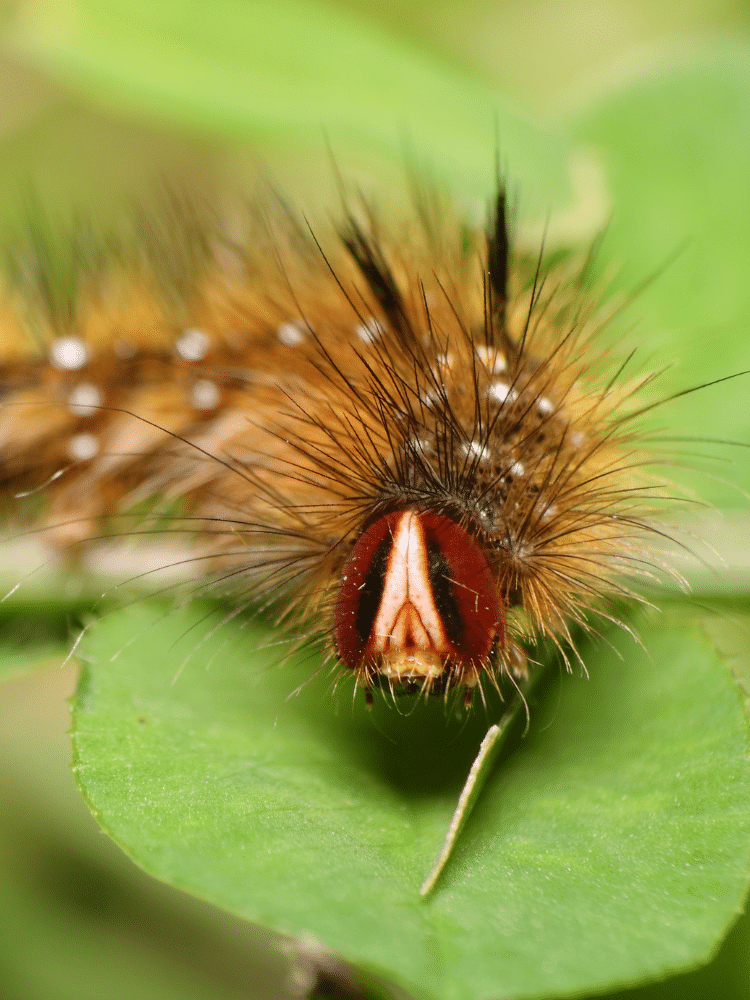
- Zebra Swallowtail: These caterpillars have an exclusive diet on young pawpaw tree leaves. Their black and white striped pattern is a direct nod to their namesake, the zebra.
- Red Admiral Caterpillars: They prefer nettle plants. These caterpillars have an interesting defense mechanism where they construct a protective tent from the plant’s leaves, hiding during the day and coming out to eat at night.
- Pipevine Swallowtails: Their primary diet consists of the pipevine plant, which makes them toxic to predators. Their black and red coloration is a warning sign in the insect world, signaling potential predators to stay away.
- Mourning Cloak Caterpillars: Willow, elm, and poplar are the chosen delicacies for these spiky black caterpillars with specks of bright colors.
- Question Mark Caterpillars: These enjoy feeding on elm, nettle, and hops. They are named for the silver mark that resembles a question mark on the wings of their adult form.
Monarch and Milkweed
The Monarch caterpillar and milkweed relationship is perhaps one of the most documented in entomology.
Nearly 90% of Monarch butterflies are found on milkweed plants, making it a crucial habitat for this species.
The glycoside toxins they ingest from these plants don’t harm the caterpillar but make them toxic to predators. A recent study showed that birds that ate Monarch butterflies had a 60% chance of vomiting afterward, teaching them to avoid these colorful insects in the future.
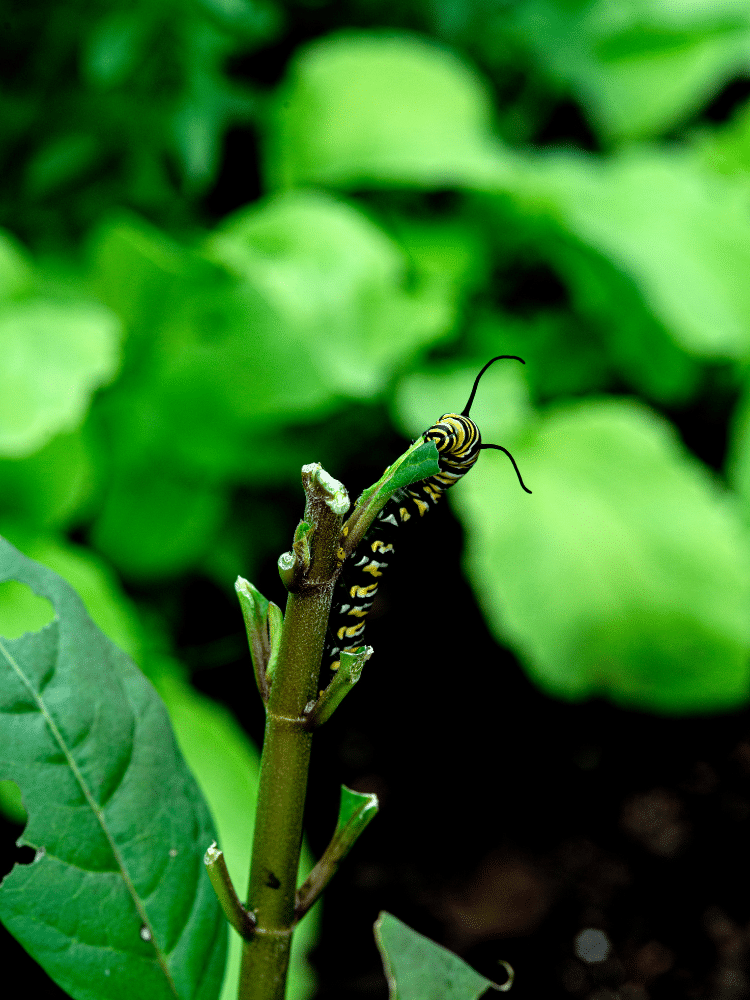
Caterpillars Pollinate… Well, Sort Of!
Caterpillars play a pivotal role in aiding plant pollination. While feeding, they often drop frass (or excrement), which attracts predatory insects. While hunting for caterpillars, these insects inadvertently pollinate the plants, leading to a fascinating interconnected web of life.
Water
You’re not alone if you’ve ever wondered whether butterflies need to quench their thirst. Water, as we know, is a staple for all living creatures. But how do butterflies manage their hydration?
While the primary focus of a butterfly’s diet is nectar, which provides them with essential sugars, amino acids, and other nutrients, they also require water for hydration.
Much like humans need water to help digest food and maintain bodily functions, butterflies, too, need H2O to process the nutrients they gather from nectar and other food sources.
How Do Butterflies Drink Water?
You won’t typically find a butterfly sipping from a puddle like a bird or a deer might. Instead, butterflies have a unique way of hydrating.
They use their long proboscis to sip water from damp spots. This can be from wet leaves, moist soil, or even dewdrops on plants.
They’re particularly fond of areas where the water contains dissolved minerals and salts, which adds to their nutritional intake. This behavior, akin to “puddling” we discussed earlier, can often be observed in nature, especially during warmer days when staying hydrated becomes essential.
Providing Food
Butterflies don’t just add a touch of beauty to our surroundings; they’re pivotal players in our ecosystem. As pollinators, they aid in plant reproduction, providing food for other wildlife.
By creating a haven for these winged wonders in our backyards, we’re not just treating ourselves to nature’s live theater but also contributing to a more balanced environment.
Want to see more butterflies flitting around your garden? Consider turning a patch of your garden (or even your entire garden!) into a butterfly sanctuary.
By planting specific plants and providing certain elements, you can make your garden the hottest spot in town for these beautiful insects.
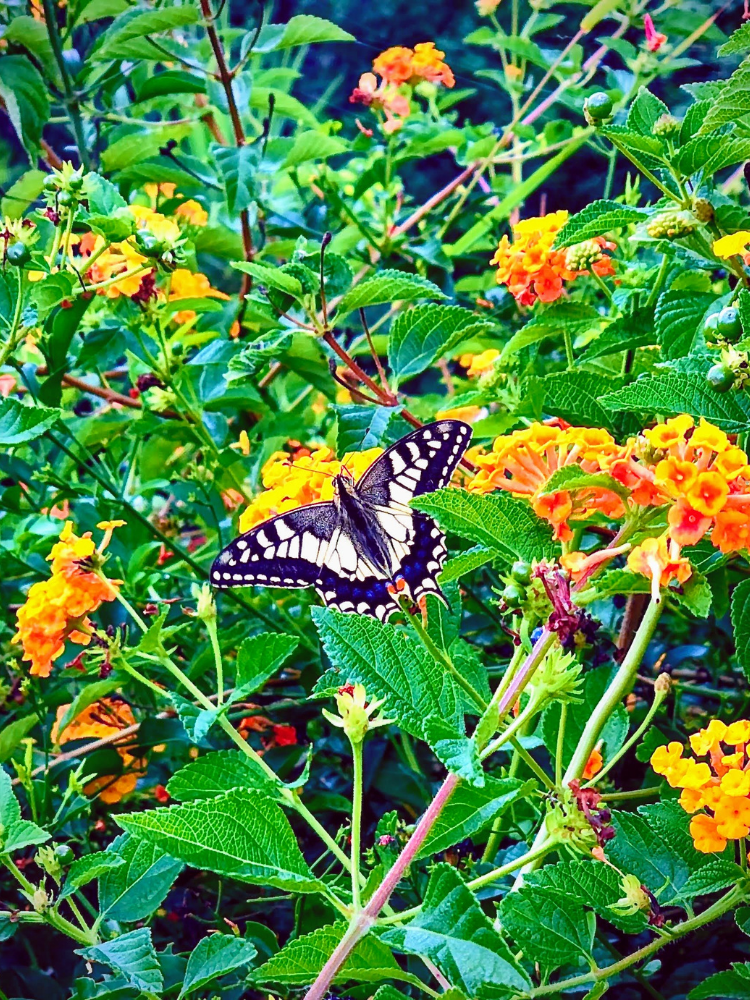
Nectar-Rich Flowers to Plant
With their innate sense for sugary treats, butterflies are always looking for nectar-rich flowers. These plants nourish them and invite them to play their essential role in pollination.
If you want to attract a myriad of these winged beauties, here’s a more comprehensive list of flowers to consider:
- Coneflowers: These hardy perennials thrive in full sun and well-drained soil. They attract a variety of butterflies like the Monarch, Painted Lady, and American Lady. Bonus: They’re also drought-resistant and come in various colors, from pink to bright orange.
- Lavender: A favorite of many gardeners due to its aromatic scent, lavender is an excellent pick for attracting Swallowtails and Skippers. It thrives in sunny locations with well-draining soil and is relatively easy to grow. Lavender is a decent catch-all plant that will attract loads of beneficial bugs.
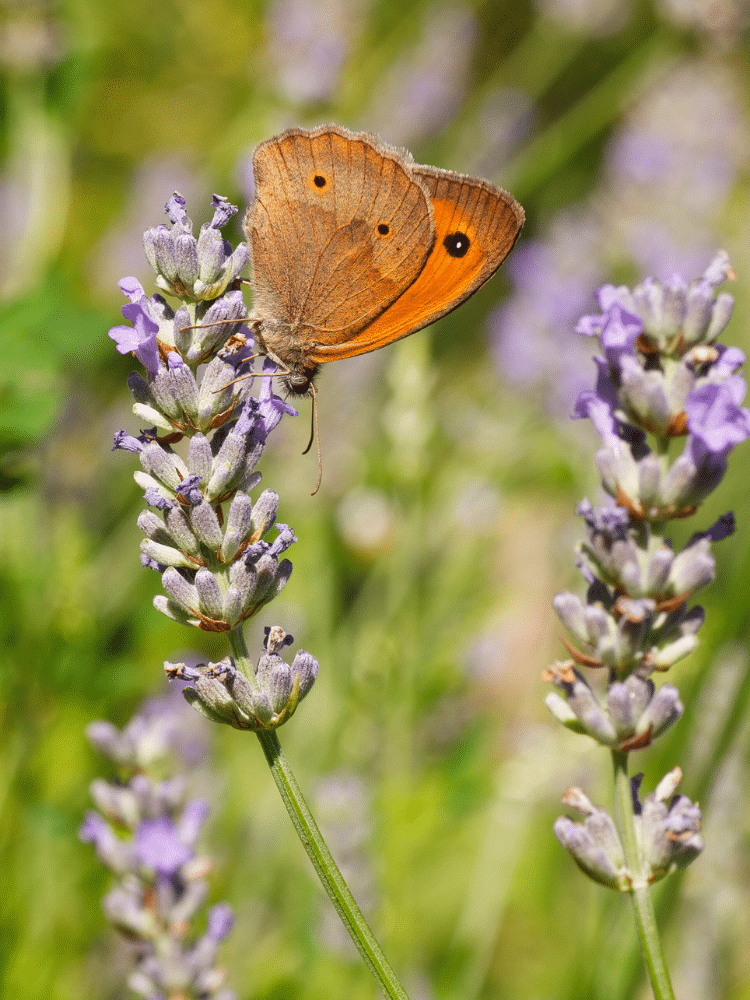
- Marigolds: These bright, sunny flowers aren’t just beautiful; they’re butterfly magnets. Especially popular with Sulphur butterflies, marigolds prefer full sun and a mix of well-draining soils.
- Butterfly Bushes (Buddleja): True to their name, these bushes are butterfly havens. They are particularly favored by the Red Admiral and Peacock butterflies. These bushes prefer full sun and fertile, well-drained soils.
- Milkweed: Essential for Monarch butterflies as it’s the only plant on which they lay their eggs. Milkweed also offers nectar to other butterfly species. It can adapt to various soils but prefers full sun.
- Zinnias: These bright, daisy-like flowers are not just eye-catching but are also loved by Monarchs, Swallowtails, and Painted Ladies. Zinnias are sun-loving plants that grow best in well-draining soil.
- Asters: With their starry-shaped flowers, asters lure in Painted Ladies, Crescents, and Swallowtails. These perennials prefer full sun to partial shade and well-draining soil.
- Goldenrod: Contrary to some beliefs, goldenrod doesn’t cause allergies (that’s ragweed!). Instead, it’s a fantastic nectar source for Monarchs and Painted Ladies. It thrives in full sun and almost any soil type.
- Lantana: These colorful clusters of flowers are favorites among hairstreaks, skippers, and fritillaries. Lantana is heat-tolerant and prefers sunny spots with well-drained soil.
Threats to Food Sources
However, creating these spaces becomes even more vital when considering the mounting threats to butterfly populations. Unfortunately, it’s widely known that butterfly populations are declining for multiple reasons.
Habitat Loss
Habitat loss is a critical issue.
As cities expand, forests fall, and farmlands spread, the natural spaces that butterflies call home are shrinking. The Xerces Society for Invertebrate Conservation has pointed out that several butterfly species in North America are now teetering on the brink of extinction due to these rapid environmental changes.
The transition from diverse ecosystems to monocultures means that the native plants, vital for butterfly sustenance and breeding, are becoming rare.
Even when habitats are not entirely lost, they may be fragmented into smaller patches – isolated. This fragmentation makes it difficult for butterfly populations to intermingle, leading to decreased genetic diversity and increased vulnerability to diseases.
Pesticides and Pollution
Pesticides and pollution compound these problems. Modern agricultural practices, heavily reliant on chemical pesticides, have unintended victims in butterflies.
Neonicotinoids, a popular insecticide choice, can be lethal to these insects.
Even if these chemicals don’t result in immediate death, they can have sub-lethal effects, like reduced reproductive capacity.
Beyond the fields, air pollution disrupts the intricate relationship between butterflies and flowers. Polluted air masks the scent trails of flowers, confusing butterflies and making their search for nectar that much harder.
Climate Change’s Impact
Then there’s the looming shadow of climate change, introducing a suite of unpredictable challenges.
A study published in 2016 in the journal “Science Direct” captured the magnitude of this issue, revealing that European butterflies have been shifting their ranges northwards in response to rising temperatures.
However, this migration isn’t always fast enough to keep pace with the climate’s rapid changes. As temperature-sensitive creatures, butterflies find their metabolic rates, feeding patterns, and even reproductive cycles altered by these changes.
The changing climate can cause a mismatch in timing, too. For example, a butterfly might emerge from its chrysalis expecting to find a particular flower in bloom, only to discover that the flower had bloomed early due to unexpected temperature surges.






